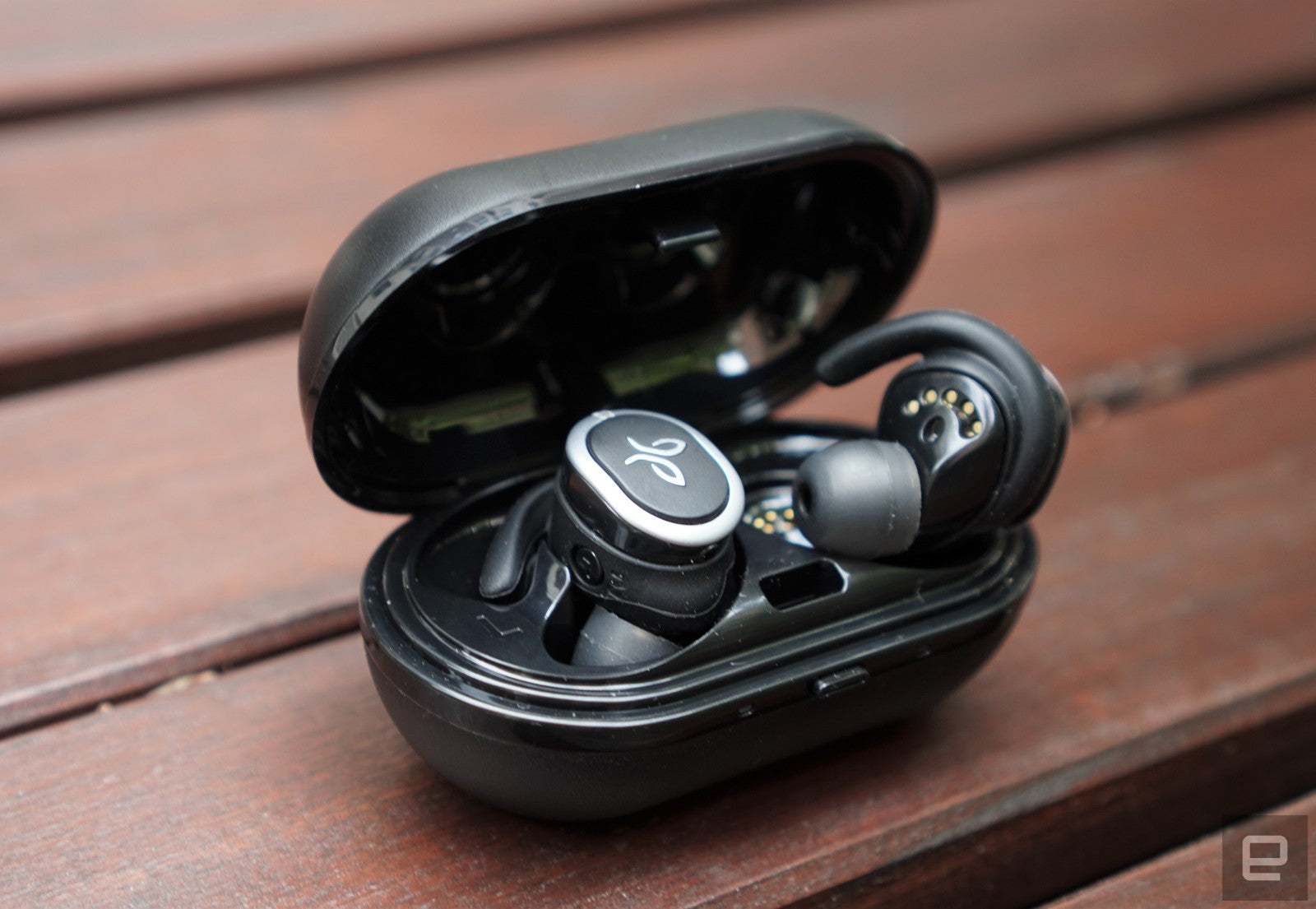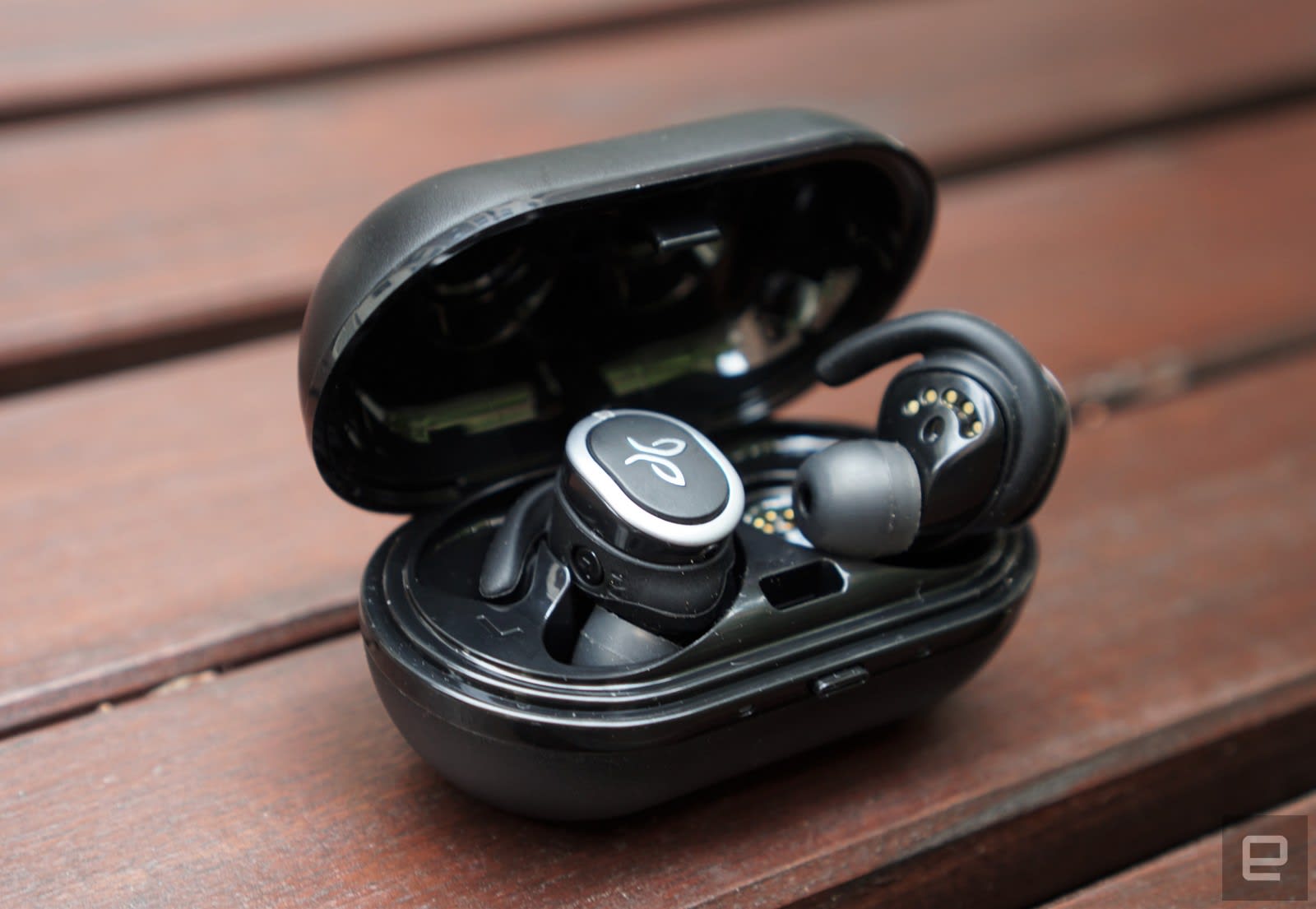Completely wireless earbuds are everywhere this year. Call it the Apple AirPods effect, or perhaps it's just a matter of the right components being available at the right time. But now that completely cordless designs are less novel than they used to be, companies have to work harder to stand out. Jaybird, which has had years of experience in wireless audio, is taking a stab at the increasingly crowded field with its $180 Run earbuds. They're comfortable, sound great for their size and offer solid reception (for the most part).

Jaybird RUN Review by Engadget
Jaybird Run review: The perfect truly wireless earbuds for workouts
Pros
- Fits comfortably and inconspicuously
- Sound-quality is on-par with other truly wireless earbuds
- Four hours of battery life (12 with the included battery case)
- Water and sweat resistant
Cons
- Buttons are tough to press while you're wearing them
- More expensive than some of the competition at $180
- Battery case could be more secure
Summary
The Jaybird Run are exactly what you'd expect from a company that's been working on wireless headphones for years. They're comfortable, easy to use and they sound great. You'll pay a bit more than similar headphones -- even Apple's Airpods -- but it's worth it for fitness fanatics.
Hardware
The Jaybird Run don't look particularly distinctive, aside from a small logo on the outside. At this point, most companies seem to be settling on a similar style for fully wireless earbuds. They generally try to make them as small as possible -- a departure from the clunky Bluetooth headsets you might be used to. One unique element here is that the metal ring around the outer edges of the Run serves as the antenna, which should technically give it a leg up on reception over competitors with internal antennas. They're about as subtle as the earbuds from Her -- noticeable, but they don't call attention to themselves either.
The differences between wireless buds come down to the earpiece design. They need to stay in your ears reliably -- there's no cord to save them from falling on the ground, after all -- and ideally, they should be comfortable enough to wear for hours at a time. This is one area where the Jaybird Run excels: It features the "fin" typically found on the brand's headphones, which fits into the upper groove of your ear to hold them in place. Once you get them in, it's hard to notice you're wearing them.

Jaybird gives you four sets of silicone tips: small and large round options as well as two different oval-shaped tips. There are also three different types of fin accessories, along with a finless one if you have very small ears. And as you'd imagine, the Run earbuds are both sweatproof and water resistant. Jaybird says they feature a "double hydrophobic nano coating" to deal with sweat, which is much tougher on gadgets than plain water.
The Jaybird Run also comes with a chunky carrying case, which adds another eight hours to its advertised four-hour battery life. The case is too large to fit comfortably in your pocket, but it's easy to chuck into a messenger bag or backpack. It can also give the Run earbuds one hour of juice with just a five-minute charge. The case could use a more secure latch though. It popped open in my bag on several occasions, which made my iPhone automatically connect to them. That was particularly annoying when it was causing my phone to deprioritize my other devices.
In use

Setting up the Run earbuds was a cinch. Within 30 seconds of tearing open the packaging, I had them securely in my ears and paired with my iPhone 6S. I was lucky enough to have a perfect fit with the default buds. It was definitely the fastest setup period I've seen with any pair of wireless headphones, even my BeatsX.
The right Run earbud handles all the connectivity with your phone. You can choose to wear it by itself if you'd rather keep one ear open (which is how I typically walk around New York City). The left earbud automatically connects to the right one over Bluetooth when you turn it on, and the sound carries over without any interruption. Everything sounds a bit compressed when you're just using the right earbud, but the audio field expands seamlessly once you turn on the left bud.
You don't have many options for controlling the Run. Each earbud has just one button. Powering them on and off takes one long press, but you can also skip forward to the next track by double-clicking them. The buttons are easy enough to find, but they're difficult to press. Pushing them simply felt painful, since doing so also jams the Run deeper into your ear. Because of that, I avoided the buttons entirely while wearing the earbuds.

When it comes to sound quality, the Run delivers far more than you'd expect, given its tiny frame. My usual round of test music tracks, including "Like A Dog Chasing Cars" from The Dark Knight soundtrack, and Little Dragon's "Klapp Klapp," all sounded great, with a healthy amount of detail and a surprising bass. The JayBird Run unfortunately had trouble with complex high notes; cymbals sometimes sounded like a distorted mess. They certainly didn't sound as good as the BeatsX or the Jaybird Freedom, both of which deliver quality that's almost on par with wired headphones.
The Jaybird Run was especially great for podcasts. Dialog sounded rich and natural, with none of the tinniness you get from some wireless headphones. And since podcasts are usually recorded at a much lower fidelity than music, they ended up being ideal for the Run's more limited audio range. I caught up on a big chunk of my podcast backlog while testing them, simply because they were so convenient to wear.
Gallery: Jaybird Run app screenshots | 5 Photos
If you like to customize your audio experience, you can also use Jaybird's mobile app to tweak the Run's sound profile. It's flat by default, but the company provides a variety of options like "Bring the bass," which boosts the low end, or "Extended listening," which cuts down harsh high notes. There are also custom profiles from athletes like Nick Rimando and Kerri Walsh Jennings, and you can find profiles from other Jaybird users as well. If you want, you can also adjust your levels manually. (I opted for the "Signature" settings, which boosts bass and high notes a bit.) The app changes the Run's sound at the firmware level, so any tweaks will apply no matter what you're listening to. If you need help finding exercise tunes, there's also a curated selection of Spotify playlists within the app.
With no wires in the way, the Jaybird Run made listening to just about anything feel completely seamless. It takes just a few seconds to pop them out of the case, and they paired with my phone quickly too. Since they're so comfortable, I occasionally forgot I was even wearing them. At times it felt like they were simply an extension of my hearing. They didn't fall out of my ears once after hours of testing, and after a while my low-level anxiety about dropping them on a New York City sidewalk evaporated.

However, my honeymoon with the Jaybird Run almost ended abruptly during my first jogging session. They simply couldn't stay synchronized in stereo mode while I was moving, a problem multiple reviewers have brought up over the past few weeks. When I asked Jaybird for comment, a spokesperson said that the unit I was testing was preproduction and not the final hardware consumers would get. Typically I'd find that answer suspicious, but since the Run earbuds aren't actually shipping to customers until later this month, all I can do for now is take the company at its word.
So that's the story of how I received a second Jaybird Run pair to review. I immediately took them out for a two-mile run around Brooklyn's Prospect Park and thankfully didn't experience any further synchronization issues. My podcasts and exercise playlist all played without incident. Compared to the Jaybird Freedom, which is wirelessly connected to your phone but still has a thin cable attaching the earbuds, the Run offered a completely different experience.
It's one thing not to have to worry about managing a headphone cable, but running through the park unencumbered by any cables felt truly liberating. I still experienced minor synchronization issues when walking around Manhattan, but that's something I've also noticed with other wireless buds. Extreme radio interference is part of the cost of living in a dense urban environment.
Jaybird's four-hour battery-life claim for the Run was close to what I actually saw. The buds would typically last for around three hours and 45 minutes during my testing. As you'd expect, that timing changed a bit if I was listening to quiet podcasts or loud music. Together with the battery case, the Run typically lasted around two to three days, depending on if I could fit in a jogging session. As our resident marathoner, Engadget's executive editor Dana Wollman notes that the Run's battery life should be fine for most runners. But you'd probably want a wired pair if you're hitting the pavement beyond four hours.
Pricing and the competition

At $180, the Jaybird Run is slightly more expensive than competing wireless earbuds. Apple's AirPods go for $159 while Bragi's The Headphonecomes in at $149. If you want to cut the cord mainly for exercise, though, the added cost will likely be worth it for the Run's sweat-and-water resistance. Jabra's Elite Sport are another solid workout alternative, but they're a lot pricier at $250.
If you're considering wireless headphones, it's worth taking a step back and considering how you plan to use them. If you're a fitness fanatic, it makes more sense to forgo wires entirely with the Jaybird Run. But if you care more about having higher audio quality and only need headphones for occasional exercise, you might be better off with something like Jaybird Freedom or BeatsX, which still have short cables.
Wrap-up

Jaybird didn't disappoint with the Run. The earbuds are everything I'd want in a pair of truly cord-free headphones. While they still require sacrificing a bit of audio quality, that's true of everything else in this category. Losing a bit of fidelity is worth it, though, if you've ever dreamt of going for a run while losing yourself to music and not worrying about any annoying cords.








发表评论